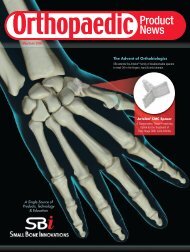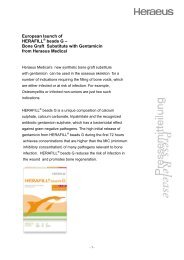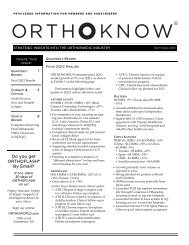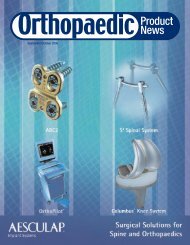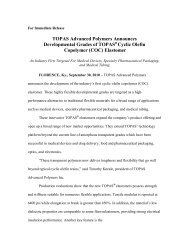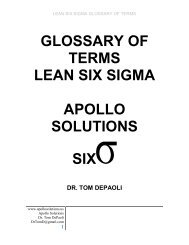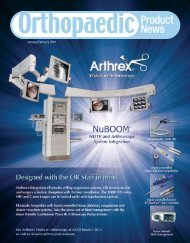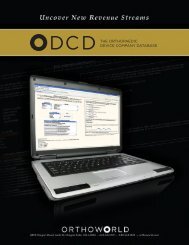FUTURETECHcontinued from page 30The 8th Association of Corporate Contributions ProfessionalsConference on Antithrombotic and Thrombolytic Therapyrecommended the following guideline for VTE prophylaxis afterelective spine surgery: 1• For patients considered being low-risk patients: early andfrequent ambulation.• For patients undergoing spine surgery who have additionalthromboembolic risk factors: postoperative low-dose unfractionatedheparin, or postoperative LMWH, or optimal use ofperioperative IPC. An alternative consideration is gradedcompression stockings.• For patients who have multiple risk factors for VTE: a pharmacologicmethod should be combined with the optimal use of amechanical method.Glotzbecker et al. 7 in a recently published review article suggestedthat optimal mechanical prophylaxis should be used routinely in mostpatients, while in higher risk patients, administration of a chemicalprophylactic agent and/or use of an IVC filter may be considered.According to the authors, the supporting data for use of anticoagulantsand the IVC filter and the optimal timing of chemoprophylaxisinitiation and duration are very limited, and therefore the exactprotocol continues to be controversial. Glotzbecker’s recommendationsand conclusions are in agreement with the current NorthAmerican Spine Society guidelines for thromboprophylaxis. 8The major disadvantage in the use of anticoagulants for DVTprevention is the increased bleeding risk associated with theirroutine usage. In spinal surgery, as in brain surgery, even minorbleeding may cause catastrophic results and permanent disability.The two most frightening complications of spine surgery are onsetof an epidural hematoma with its potentially tragic complications(not always reversible, even after an immediate revision anddecompression) or a deep hematoma with a consequent infection.Platzer et al. 9 found a postoperative epidural hematoma rate of0.6 percent and a minor bleeding rate of two percent in 978 traumapatients who underwent spinal surgery; of these, 945 patientsreceived LMWH after surgery, though the time at which it wasinitiated was not reported. Thorough literature review confirmedthat the incidence of postoperative epidural hematoma after spinesurgery is less than one percent. 7Spine surgeons have to weigh the risk of a symptomatic postoperativeepidural hematoma against the benefit of DVT/PE preventionwhen deciding to initiate chemoprophylaxis and, in theabsence of universally accepted guidelines, surgeons are reluctantto initiate chemical anticoagulants immediately after spinal surgery.Thus, anticoagulation is frequently delayed for a period of timeuntil the risk for postoperative bleeding is perceived to besufficiently low. As already mentioned, this delay in prophylaxisinitiation may lead to suboptimal DVT prevention.Another option that the spine surgeon my take in this situationis to completely avoid the VTE prophylaxis. Janku 10 in survey studyfound that only 21 percent of spine surgeons used prophylaxis in allpatients, a further 21 percent used it only in “high-risk” cases and58 percent of surgeons did not employ any kind of prophylaxis.This classic dilemma of the surgeon, forced to choose between avery potent chemoprophylaxis that carries an increased risk ofbleeding and a mechanical-prophylaxis that may be less effectivebut much safer, may now have a solution with a recentlydeveloped, portable, battery-operated lower extremity pneumaticcompression device. The device is able to synchronize its compressionactivity to the respiratory related venous phasic flow. Theclinical efficacy and safety of this new device were proven to bevery high in several prospective, randomized clinical studies thatalso demonstrated its superiority over both standard IPCs andLMWH (Lovenox). The system seems to offer patients and surgeonsoptimal DVT prevention without the exposure to bleeding complicationsassociated with the use of anticoagulants.The device, called ActiveCare+SFT® (Synchronized FlowTechnology), combines a miniature mobile unit with compressionsleeves that can be easily wrapped around the patient’s leg or footduring and after surgery. (See Exhibit 1.) It weighs 1.65 pounds andcan be operated either by battery or wall socket. It was designed toprovide Continuous Enhanced Circulation Therapy (CECT) andrepresents a new category of mechanical devices.Exhibit 1:Mobile Compression UnitThe system identifies thepatient's venous blood flowpulses and its compression isthen synchronized to thesenatural rhythms. Thistechnology allows significantamplification of the venousflow pulsatility 11 with onlyminor changes in the deviceimpact on the legs, thusproviding gentle pressure which delivers an optimal hemodynamicprofile tailored to the patient’s specific physiology. The production ofhigher blood flow speed and pulsatility generated by the device, itscompact size and the fact that it can be used 24/7 throughout the entirehigh-risk period (both in the hospital and post-discharge) give it adefinite advantage over traditional IPCs, as was demonstrated in aprevious total joint arthroplasty study performed at the ClevelandClinic. 12 The device's compact design, which allows patients to be freelyambulatory, has resulted in a dramatic 50 percent increase in patientcompliance compared to IPC systems. 13,14 Patient compliance can bemonitored on the LCD screen, thereby providing critically importantfeedback for caregivers, physicians and patients themselves.The combination of this increase in usage compliance with uniqueimproved hemodynamic profile was shown, in three different clinicaltrials, to significantly increase the device’s clinical effectiveness inDVT prevention. All three clinical trials were performed on high-riskorthopaedic patients with VTE as the primary endpoint. In the first,the new CECT device was studied against standard IPC, when bothdevices were used over LMWH. The replacement of the IPC with theCECT device caused a 70 percent relative risk reduction. (Seesummary at the end of this article.) 12The second study compared the CECT head to head withLMWH and demonstrated a 77 percent relative risk reduction in theCECT group. (See summary at the end of this article.) 15 In these twostudies, the CECT system was used on in-hospital total hip arthrocontinuedon page 3332 ORTHOPAEDIC PRODUCT NEWS • November/December 2009
FUTURETECHcontinued from page 32plasty (THA) and total knee arthroplasty (TKA) patients.The third study was designed to also include the moredemanding outpatient environment, in which patients’ mobility isgradually increasing and professional assistance is limited. In thisstudy, the ActiveCare+SFT device was compared with LMWH in aprospective randomized clinical trial that took place in nine leadingU.S. medical centers (the S.A.F.E. study, standing for SFTAlternative For Enoxaparin). The study was done on 414 patientswho underwent THA and its endpoints were VTE and bleeding.This is the first and only study so far comparing a device to LMWHthat carried both treatment arms through the recommended tendays of treatment (in-hospital + out of hospital treatment). Studyresults demonstrated that the new CECT device is as effective as thepotent anticoagulant in preventing VTE, but with significantly lessbleeding complications. (See summary at the end of this article.) 16Based on these results, the medical centers that participated inthe study have switched to using the ActiveCare+SFT as a standalone agent for DVT prevention, according to the study protocol.Summary of Relevant Clinical PapersCECT + LMWH vs. IPC + LMWH 12Objective: This non-randomized (sequential), comparative,performance study was designed to compare the efficacy of theCECT system with that of a standard IPC device for VTEprophylaxis.Design: 1,577 THA and TKA patients were available for perprotocol analysis:During the first 12 months of the study, 1,354 patients weretreated with combination of standard IPC+LMWH. In thefollowing three months, 223 patients used CECT+LMWH.Bilateral duplex scan was performed before discharge.Results: The replacement of the standard IPC by the CECTsystem significantly reduced the VTE rate (70 percent RelativeRisk Reduction, P< 0.05). The average hospital LOS was shorterfor patients in the CECT group (4.2 days vs. five days). Patients’compliance was significantly higher for the mobile CECT systemthan for the IPC (83 percent vs. 49 percent).Conclusion: The portable CECT system proved significantlymore effective than the standard IPC when used in conjunctionwith low-molecular-weight heparin for DVT prevention in highriskorthopaedic patients. Exhibit 2 provides a visual representationof results.CECT vs. LMWH (in-hospital prophylaxis) 15Objective: This prospective, randomized, comparative studywas designed to evaluate the efficacy of the CECT protocol incomparison with standard LMWH protocol for VTE prophylaxisin in-hospital patients.Design: 121 THA and TKA patients were prospectively randomizedinto two treatment groups: 61 patients were treated withCECT system starting immediately after the induction ofanesthesia; 12 hours after surgery 100 mg aspirin per day wasadded. The 60 control group patients received 40 mg enoxaparinper day, starting 12 hours after surgery. Bilateral venographywas performed before discharge.Results: In the CECT group, as compared with the enoxaparingroup, there was a significantly lower overall rate of DVT (77pecent Relative Risk Reduction, p=0.002) and a lower rate ofproximal DVT (84 percent Relative Risk Reduction, p=0.049).Multivariate analysis for prediction of DVT incidence revealedsignificant superiority of the new CECT protocol overenoxaparin protocol (Odds Ratio 6.5, p=0.002).Conclusions: The CECT based protocol proved significantlymore effective than LMWH for DVT prevention in high-riskorthopaedic inpatients. Exhibit 3 provides a visual representationof results.Exhibit 3: Summary of CECT vs. LMWHExhibit 2: Summary of CECT vs. IPCcontinued on page 34November/December 2009 • ORTHOPAEDIC PRODUCT NEWS 33



